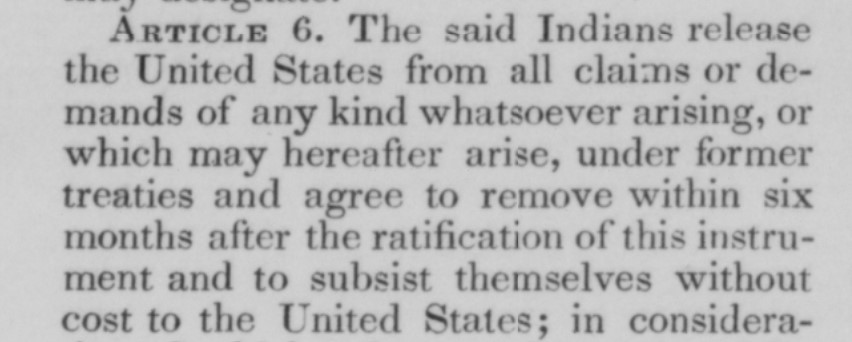Nineteenth Century Treaties with Native American Nations: Highlights from Native American Tribal Histories
This is the second in a series of blog articles highlighting primary source content from the Readex Native American Tribal Histories collection. The articles in this series offer further insight and added perspectives into westward expansion, the Trail of Tears, the history of Manifest Destiny, and the impacts to Native Americans.
“…the President may change at any time or modify this clause as he may think proper…”: Treaties with Native Groups in the Nineteenth Century

In addition to a policy of Native removal, the Bureau of Indian Affairs made hundreds of treaties with Native American nations, all of which were intended to weaken the power of Native resistance to American expansion. By systematically reducing Native American territories, requiring Native nations to declare their dependency to the government of the United States, and undermining Native sovereignty and cultures on the lands they still held, the Bureau hoped to put a definitive end to Native opposition.
Territorial Land Reduction
Many treaties demanded Native nations relinquish huge portions of their territory to the United States and remove to designated reservations within specific time limits. In the treaty signed 18 May, 1854, the Sauk and Fox nations of the Missouri ceded:
all their right, title and interest in and to the country assigned to them by the treaty concluded on the seventeenth day of September, one thousand eight hundred and thirty-six, between William Clark, superintendent of Indian affairs, on the part of the United States and the Ioways and Missouri Sacs and Foxes, being the lower half of the country described in the second article thereof as ‘the small strip of land on the south side of the Missouri River, lying between the Kickapoo northern boundary line and the Grand Nemahaw river, and extending from the Missouri back and westwardly with the said Kickapoo line and the Grand Nemahaw, making four hundred sections; to be divided between the said Ioways and Missouri band of Sacs and Foxes; the lower half to the Sacs and Foxes, the upper half to the Ioway;’ saving and reserving fifty sections, of six hundred and forty acres each, which shall be selected in the western part of the cession by the delegates, parties hereto, and the agent for the tribe after their return home, and which shall be located in one body and set off by metes and bounds…[i]


In a stroke of the pen, the United States government reduced the lands claimed by the Sauk and Fox from 256,000 acres to just 32,000 acres.
In November of 1854, the Shawnee signed a treaty which reduced their territory from 1.6 million acres to just two hundred thousand – an eighth of their previous range. Like the Sauk and Fox earlier the same year, the Shawnee had already signed a treaty which set apart lands for them – territory which they were now forced to cede to the United States.[ii]
In February of 1855, the Oto and Missouri nations signed a treaty in which they ceded “all their country west of the Missouri River” retaining only “a tract of land ten miles wide by twenty-five miles long…” which reduced their territory to just 160,000 acres.[iii]
The Pawnee signed a similar treaty in May of 1858, which provided “a tract of country, thirty miles long from east to west, by fifteen miles wide from north to south, including both banks of the Loup fork of the Platte river…”, an area of approximately 288,000 acres.[iv]
The Ponca in April 1859, and the Sauk and Fox of the Mississippi in 1860 would sign similar treaties.[v]
Once established, this pattern of reducing Native American territories through treaty-making would remain policy until 1871 when the United States government declared it would no longer recognize the sovereignty of Native nations, obviating the need for treaties.[vi]
Removal from lands, retributions, and dependence on the U.S. government
Many treaties also required Native nations to “remove” to their reduced territory within a short period of time, usually one year from the date of ratification, and explicitly nullified the terms of previous treaties.
In the treaty of May 1854, the Sauk and Fox of the Missouri agreed to:
release the United States from all claims or demands of any kind whatsoever arising, or which may hereafter arise, under former treaties and agree to remove within six months after the ratification of this instrument and to subsist themselves without cost to the United States…[vii]

Most treaties required Native nations to acknowledge their “dependency” on the United States government and extracted promises of friendliness to both United States citizens and other Native groups.
In their May 1858 treaty, the Four Confederated bands of Pawnee acknowledged
...their dependence on the government of the United States, and promise to be friendly with all the citizens thereof, and pledge themselves to commit no depredations on the property of such citizens, nor on that of any other person belonging to any tribe or nation at peace with the United States. And should any one or more of them violate this pledge, and the fact be satisfactorily proven before the agent, the property taken shall be returned, or in default thereof, or if injured or destroyed, compensation may be made by the government out of their annuities. Nor will they make war on any other tribe, except in self-defence, but will submit all matters of difference between them and other Indians to the government of the United States, or its agent, for decision, and abide thereby.[viii]

Similar pledges of dependence and friendliness were demanded of the Shawnee in 1854, the Oto and Missouri in 1855, and the Ponca in 1859. The legal language obscures the reality; many Natives stole from whites and other Native groups out of necessity. By cutting off this avenue of survival, the United States government ensured Native nations would be forced to rely upon the Bureau of Indian Affairs for resources or face reprisals.
In addition, treaties with Native groups often contained language which demanded specific behavior. Native nations were required to abstain from using alcohol, send their children to schools organized and maintained by the United States government, and make other efforts at “civilization.”
The treaty with the Sauk and Fox of Missouri in May, 1854 declared:
The said Indians promise to use their best efforts to prevent the introduction and use of ardent spirits in their country; to encourage industry, thrift and morality; and by every possible means to promote their advancement in civilization.[ix]
Should they fail in this, the treaty with the Ponca in April of 1859 outlined the consequences:
To aid in preventing the evils of intemperance, it is hereby stipulated that if any of the Poncas shall drink, or procure for others, intoxicating liquor, their proportion of the tribal annuities shall be withheld from them for at least one year; and for a violation of any of the stipulations of this agreement on the part of the Poncas, they shall be liable to have their annuities withheld, in whole or in part, and for such length of time as the President of the United States shall direct.[x]

Residential Schools
The United States government also required Native children to attend schools run by the government, sequestered from their families and cultures. The treaty signed by the Pawnee in May 1858 stated:
In order to improve the condition of the Pawnees, and teach them the arts of civilized life, the United States agree to establish among them, and for their use and benefit, two manual labor schools, to be governed by such rules and regulations as may be prescribed by the President of the United States, who shall also appoint the teachers, and if he deems it necessary, may increase the number of schools to four. In these schools, there shall be taught the various branches of a common school education, and, in addition, the arts of agriculture, the most useful mechanical arts, and whatever else the President may direct. The Pawnees, on their part agree that each and every one of their children, between the ages of seven and eighteen years, shall be kept constantly at these schools for, at least, nine months in each year; and if any parent or guardian shall fail, neglect, or refuse to keep the child or children under his or her control at such school, then, in that case, there shall be deducted from the annuities to which such parent or guardian would be entitled, either individually or as parent of guardian, and amount equal to the value, in time, of the tuition thus lost; but the President may change at any time or modify this clause as he may think proper.[xi]

Similarly, the treaty with the Ponca in April 1859 stated,
It is further agreed that such other measures may be adopted to compel the attendance of the children at the school or schools as the President may think proper and direct…[xii]
Land, Homes, and Agriculture
Native Americans were further required to take up agriculture and abandon their traditional ways of life. The treaty with the Oto and Missouri in 1855 stipulated,
And if any such person or family shall at any time neglect or refuse to occupy and till a portion of the land assigned, and on which they have located, or shall rove from place to place, the President may, if the patent shall have been issued, revoke the same, or if not issued, cancel the assignment, and may also withhold from such person or family, their proportion of the annuities or other moneys due them, until they have returned to such permanent home, and resumed the pursuits of industry; and in default of their return, the tract may be declared abandoned, and thereafter assigned to some other person or family of such confederate tribes, or disposed of as is provided for the disposal of the excess of said land. And the residue of the land hereby reserved, after all the Indian persons or families of such confederate tribes shall have assigned to them permanent homes, may be sold for their benefit, under such laws, rules or regulations as may hereafter be prescribed by the Congress or President of the United States.[xiii]

Should Native Americans resist, their annuities could be withheld, and their homes and lands could be taken away.
In the April 1859 treaty with the Ponca, annuities could be discontinued “should said Indians fail to make satisfactory efforts to advance and improve their condition; in which case such other provision shall be made for them as the President and Congress may judge to be suitable and proper.”[xiv] No definition of “satisfactory efforts” was made, nor was it clear what provisions might be thought “suitable and proper” by the federal government.
Denial of annuities was a frequent tactic by the United States government because these payments and supplies were vital to Native communities removed to remote reservations; isolated as they were from white communities and trading networks with other Native groups, Native Americans relied on annuity payments and goods to survive through the year.
U.S. Government Control
The treaties often placed huge discretionary power in the hands of the President of the United States and Congress. Many articles included language which placed responsibility with the President and Congress to make sweeping changes to the terms of the treaties as they saw fit.
In the treaty with the Confederated Sauk and Fox of the Mississippi in 1860, Article Seven granted the federal government carte blanche to alter the terms of the treaty.
And, in order to render unnecessary any further treaty engagements or arrangements hereafter with the United States, it is hereby agreed and stipulated that the President, with the assent of Congress, shall have full power to modify or change any of the provisions of former treaties with the Sacs and Foxes of the Mississippi in such manner and to whatever extent he may judge to be necessary and expedient for their welfare and best interest.[xv]
While the treaties implied nothing would change if the Natives acted as they were directed by the U.S. government, there was no language in them which provided recourse for unfair treatment by agents or the government. It is therefore unsurprising that many Native nations violently resisted subjugation under the United States government, given the treaty terms under which they endured.
The next installment of this series will examine the wars fought by Native peoples against American expansion.
[i] [Treaty with the Sauk and Fox, May 18, 1854]
[ii] [Treaty between the United States and the Shawnee, Nov. 2, 1854], [Treaty with the Sauk and Fox, May 18, 1854]
[iii] [Treaties with the Oto and Missouri of Indians]
[iv] [Proclamation of the Treaty between the United States and the Four Confederate Bands of Pawnee, May 26, 1858]
[v] [Treaty between the United States and the Ponca, April 11, 1859], [Treaty between the United States and the Confederated Tribes of Sacs and Foxes of the Mississippi, 1860]
[vi] United States Code Title 25, Chapter 3, Subchapter 1, Section 71.
[vii] [Treaty with the Sauk and Fox, May 18, 1854]
[viii] [Proclamation of the Treaty between the United States and the Four Confederate Bands of Pawnee, May 26, 1858]
[ix] [Treaty with the Sauk and Fox, May 18, 1854]
[x] [Treaty between the United States and the Ponca, April 11, 1859]
[xi] [Proclamation of the Treaty between the United States and the Four Confederate Bands of Pawnee, May 26, 1858]
[xii] [Treaty between the United States and the Ponca, April 11, 1859]
[xiii] [Treaties with the Oto and Missouri of Indians]
[xiv] [Treaty between the United States and the Ponca, April 11, 1859]
[xv] [Treaty between the United States and the Confederated Tribes of Sacs and Foxes of the Mississippi, 1860]
Other blogs in this series:
Visit the Readex Native American Tribal Histories page for information on this collection and to request a complimentary trial.



